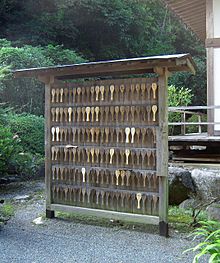Shamoji facts for kids
A shamoji (しゃもじ, 杓文字), or rice paddle, is a large, flat spoon used in cooking, especially in East Asian countries. It is mainly used to stir and serve rice. It's also great for mixing vinegar into rice when you are making sushi.
Contents
What is a Shamoji Made Of?
Traditionally, shamoji were made from natural materials like bamboo, wood, or a special kind of lacquer. Today, you will often find them made from plastic. When using a shamoji, people often dip it in water. This helps stop the rice from sticking to the spoon. Some fancier plastic shamoji even have special surfaces that don't let rice stick at all! You rarely see shamoji made of metal. This is because metal can cut the delicate rice grains or damage the wooden tub, called a hangiri, which is often used for mixing sushi rice.
The History of the Shamoji
People say the shamoji was first invented by a monk on Itsukushima Island in Japan. The word shamoji itself comes from older Japanese words. It combines part of the word for "ladle" (shakushi) with the word for "character" (moji).
How Shamoji are Used Today
Many modern rice cookers come with a shamoji right in the box, usually a simple white plastic one. Besides serving rice, shamoji can also be used to gently crush soft vegetables, like garlic or cucumbers. It's a bit like how people in Western cooking might use a cleaver knife for similar tasks.
A Symbol of Family
The shamoji has also been an important symbol in Japanese families. It represents the connection between a mother and her wife (or daughter-in-law). In some traditions, the shamoji was passed down from one generation to the next. This showed how family duties and traditions were being handed over to the next person in charge of the home.
See also
 In Spanish: Shamoji para niños
In Spanish: Shamoji para niños




